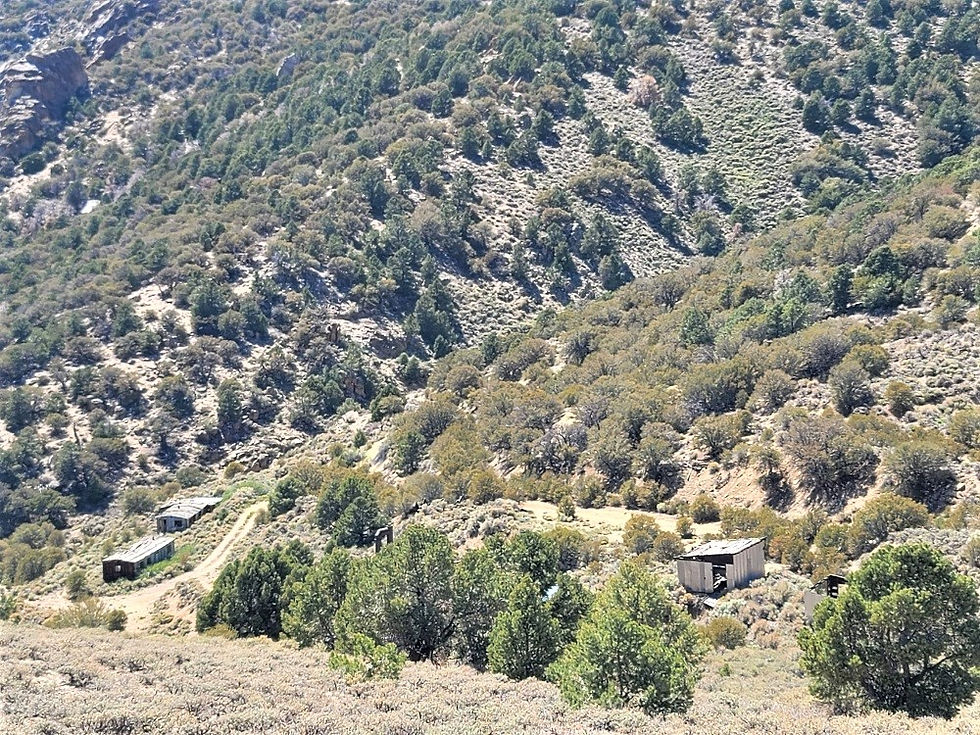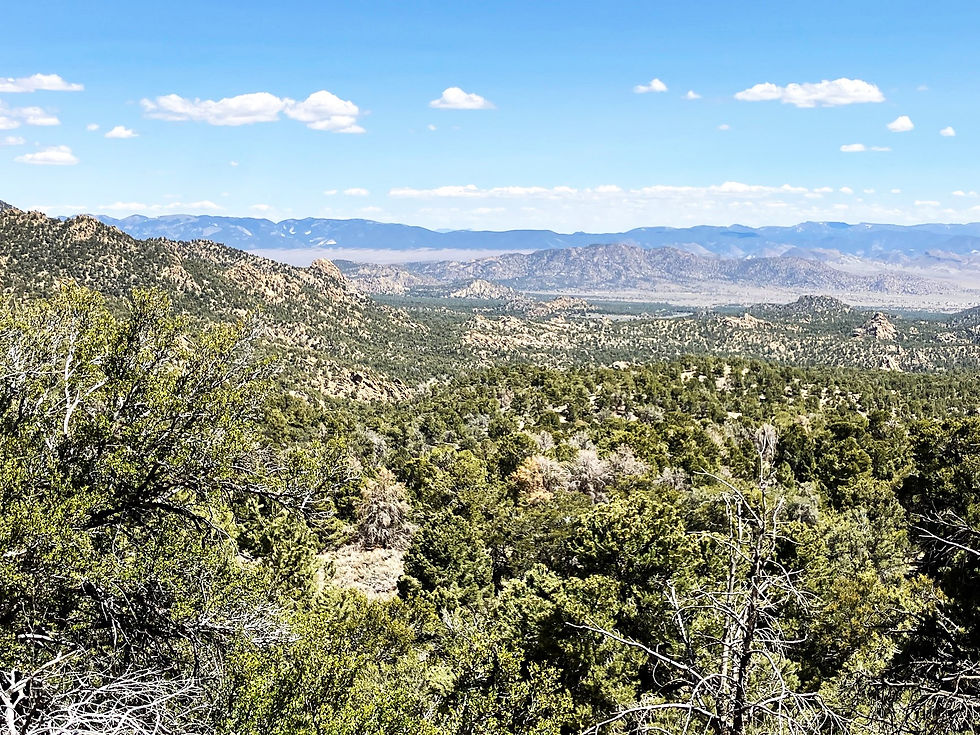Van Ness Mine




Nye County
AKA: Raymond Van Ness Mine
In July 1928, the home of C.E. Van Ness in Tonopah burned down. He had recently arrived in Tonopah from Los Angeles. By the fall, he was living at and overseeing the Van Ness quicksilver property. By November of 1928, Frank Buol (Pahrump) and Peter Buol (B & B Quicksilver Company) showed an interest in the mine. By December, Nelson Hickernell was also involved with the claim. The company was listed as the Raymond Van Ness Mining Company, with C.E. Van Ness managing. Four men were currently employed. The company planned to install a furnace in the spring. Peter Buol and P.B. Shelby called it the best quicksilver property in Nevada. Through the spring, Peter Buol continued to show interest in the property. By May, company officers were listed as C.E. Van Ness- President; William Giffeney- Vice President; Peter Buol- Unnamed Title. The three men were investigating the costs of building a forty-ton plant. Not much was reported through the summer. In September, the company finished a lengthy road up to the camp. They announced official plans to install a forty-ton Gould rotary furnace in early 1930. The Reno Gazette stated that the property was originally discovered by John and Charles Humphrey in August of 1928. They immediately sold it to C.E. Van Ness fifteen days later. William Geffney (Giffeney, Geffrey) of L.A. was now described as the Secretary-Treasurer. In May of 1930, it was announced that construction had begun on a 30-ton Cottrell (Cotterill) rotary furnace. Another report described it as 20-ton. Peter Buol was now supervising operations at the mine. C.F. Wittenberg received the contract to haul in the furnace equipment. He described it as the toughest job that he had ever done. C.E. Van Ness expected it to be producing by mid-July. The furnace made its test run on July 7, 1930. They planned to spend the week making adjustments. By the end of July, Mrs. Buol and their daughter Dorothy arrived at the mine from Los Angeles. By mid-August, Buol arrived in Tonopah with the first shipment of 25 flasks of mercury bound for San Francisco. Through August, four more shipments of 30 flasks, 25 flasks, 14 flasks and 17 flasks had been made. The company was producing as many as 6 flasks a day. This volume was completed, even with a furnace problem that shut them down for four days. Production slowed down slightly through September, with 35 flasks being shipped on September 23, followed by 25 flasks on October 6. By December 7, it was reported that 220 total flasks had been shipped since the furnace started. By December the mine was down 130 feet, with ore averaging six to eight pounds of quicksilver per ton. Flasks continued to be shipped through December, with production leveling off at 2 flasks per day (60 per month) through the end of January. Bids were coming in at $96 per flask. Production declined in February due to inclement weather and a need to pump water from the mine. A shot opened a crevice that allowed over three million gallons of water to flood the mine. At the time of the flood, the company was not in possession of the equipment needed to pump the water. By March of 1931, Buol was listed as the President and Manager of the Raymond Van Ness Company. Water issues continued to slow production through early April. On April 17, 1931, Roy Watson had his nose shattered while starting a compressor. The Reno Gazette stated that he “was struck by a flying crank”. He was treated at the Miners Hospital in Tonopah. Upon solving the water issue, production was again stabilizing at an expected 60 flasks per month. New electrical equipment was ordered and expected to be in place by summer. By May, the equipment of the Rock Hill plant between Coaldale and Mina had been purchased by the company. This included a 75-horsepower diesel plant and compressor for increased drilling capacity. It was purchased for pennies on the dollar at a tax sale. The sale also included five miner’s houses. Progress on installation continued through May, although Buol was not optimistic about quicksilver prices. The project was completed in June while prices fell. Buol took the opportunity to further develop the mine. The pump was now able to pump sixty gallons a minute from a continuing flooding problem in the mine. Fourteen men were currently employed at the camp, working three shifts. The shaft was now down to 220-feet. In August, a major stockholder in the company named Byron Kirby visited the mine. “MINER INJURED IN MINE CAVE-IN”. In mid-August 1931, a 40-year-old miner named Tom Malkovich received a broken leg and back injuries after the mine caved on him. Mine Superintendent W.T. Brodie was in Tonopah at the time. The foreman sent message to Dr. Craig of the miner’s hospital to travel to the mine, as Malkovich could not be moved. While Dr. Craig was traveling up the badly washed-out road, they met Malkovich and the foreman. Malkovich was taken to Tonopah. By the end of September, major stockholders B.C. McCabe, Frank Wood and Jack Rosenberg of L.A. called for a refinancing of the company. This came on the heels of the costly installation of the plant, along with a decrease in quicksilver prices ($73 a flask). This led to labor liens being filed with the labor commissioner against the company. The stockholders intended to settle all claims. However, by the middle of November, this had not been settled. Buol was summoned to appear at a hearing regarding the matter. Judge J. Emmet Walsh ruled in favor of the claimants and ordered the property sold to settle a lien of $6,34212 and court costs of $592. A few weeks later, Buol narrowly escaped death about six miles east of Tonopah on what would be modern-day Highway 6 when his car rolled and landed on the roof. “The top was crushed like a bellows and Buol was saved by a box of supplies he had placed in the rear seat.” A box of supplies landed in a spot that stopped a portion of the roof from fully caving in, saving his life. Buol was said to have escaped without a scratch. On December 11, 1931, the Reno Gazette reported that the Raymond Van Ness mine had been taken by Sheriff Thomas on orders of Labor Commissioner William Royle. The equipment was not included with the property. The company was given six months to redeem the property. In January of 1932, Mr. and Mrs. James Vassar, the former foreman of the Van Ness mine welcomed their fifth daughter. A nine-pound girl was born in the miner’s hospital. By the end of February, stockholders B.C. McCabe (stockbroker), Frank Wood (banker), M.A. Pincus and Paul Hofacker (mining men) all of L.A, made plans to financially overhaul the company. On April 13, 1932, an update was offered on Tom Malkovich. He was previously injured in the cave-in. He was back in the Tonopah Miner’s Hospital after traveling to San Francisco with Dr. R.R. Craig to see a specialist. His care was under the authority of the Nevada Industrial Commission. By June 1932, issues regarding the property and labor liens were thought to be resolved. The company returned to work with a full crew. Immediate plans included driving down to seven or eight hundred foot-level. Peter Buol remained as Manager. The stockholders provided a vote of “Confidence” in the management. Another labor issue arose by October 1932 in a case involving State Labor Commissioner William Royle against J.W. Draper and Peter Buol. Although details were very limited, a court order ruled against Draper and Buol. This appeared to stop the Van Ness Company from performing any further work at the mine. News disappeared until October of 1933 when it was stated that Gordon and Brodie now owned the Van Ness mine. They were preparing to remove equipment to a property in Esmeralda County. News again disappeared until January of 1936 when the Nevada State Journal ran the headline “Woman Miner Has Rich Quicksilver”. Mrs. Cramer along with her son and daughter-in-law took a lease on the property, which she received on July 29, 1935. They removed 63 flasks of mercury in 1935 using a pipe retort. Mrs. Cramer went back to Louisiana to spend the winter, with plans to resume in the spring of 1936. She also intended to take over the Flowers property to the north. News again disappeared until April of 1940 when a new operation was started by John Connolly and Homer Williams. They were well-known Tonopah mining men. A two-drill compressor was installed, five men were employed, and a boarding house was built. Plans for new construction were planned for the summer. The furnace was also being reconditioned. By mid-May, six men were employed to tap the ore body at the four-hundred-foot level. Connolly and Williams oversaw the mine while J.H. Smith of Tonopah oversaw the mill. This operation was short-lived. By June, Paul Martin and his brother were leasing the mine, with use of the mill. In July of 1941, it was reported that Mr. Spencer was renovating the furnace on behalf of Connolly and Williams. The two men had plans to re-start the mine shortly. There was an abundance of ore on the dumps. However, no further reports were located that indicated that this ever happened. By late January of 1957, A.D. ‘Andy’ Drumm Jr. of the Silver State Construction company in Fallon obtained a lease on the property from Connolly and Williams. Drumm planned on moving equipment in to conduct development work under the supervision of Geologist Keith N. Meador of Reno. No further news on activity at the Van Ness mine was discovered. END.
Last Trip/ Road Conditions: July 2022 and May 2024. This road was very rough and rocky. While it was okay in side-by-sides, I would not try this in my four-wheel-drive truck.
Sources: Newspapers of the era. Mainly consisting of the Reno Gazette and Nevada State Journal.